Chapter: Civil : Construction Materials: Lime, Cement, Aggregates, Mortar
Testing Of Aggregates
Testing Of Aggregates
The size,
shape, grading of aggregate and their surface moisture affect directly the
workability and strength of concrete whereas soundness, alkali-aggregate
reaction and presence of deleterious substances adversely affect the soundness
and durability of concrete. The following tests are conducted to ensure
satisfactory performance of aggregate
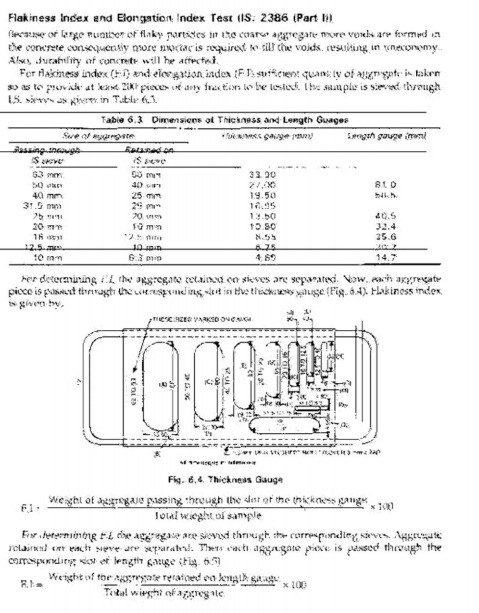
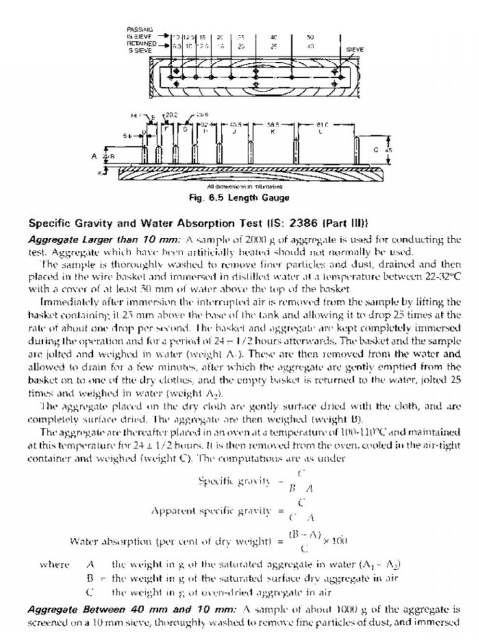
Table Weights of Sample
Max. size
present in substantial Proportion (mm) : Approximate sample weight (g)
63 to 25 : 6000
20 to 12.5 : 1000
10 to 6.3 : 500
4.75 or smaller : 300
For testing fine
aggregate for clay, fine silt and dust weight approximately 300g of the air
dried sample, passing the 4.75 mm IS sieve, and place it in the screw-topped
glass jar, together with 300 ml of diluted sodium oxalate solution. The jar is
then rotated about its long axis (with this axis horizontal) at a speed of 80
rpm for 15 minutes. The suspension is then poured into 1000 ml measuring
cylinder and the residue washed by gentle swirling and decantation of
successive 150 ml portions of sodium oxalate solution, the washings being added
to the cylinder until the volume is made up to 1000 ml.
For coarse
aggregate the sample is placed in a suitable container, covered with a measured
volume of sodium oxalate solution (0.8 g/l), agitated vigorously and the liquid
suspension transferred to the 1000 ml measuring cylinder. The process is
repeated until all clayey material is transferred to the cylinder. The volume
is made upto 1000 ml with sodium oxalate solution.
The percentage of fine
clay, silt and dust, A, is

Where W1 = weight of original sample (g)
W2 = weight of dried sample (g)
V = volume of the pepette (ml)
0.8 = weight of sodium oxalate (g) in
one litre of the dilute solution.
Note: These impurities should not exceed 3% for fine and coarse
aggregates except for crushed
fine aggregate for which the limit is 15% (IS:383).
Aggregate Smaller than 10 mm: A Pycnometer
shown in Fig. 37 is used for specific gravity. A sample about 1000 g for
10 mm to 4.75 mm or 500 g if mm, is placed in the tray and covered with
distilled water at a temperature of 22-32 o C. Soon after immersion, air
entrapped in or bubbles on the surface of the aggregate are removed by gentle
agitation The sample is kept immersed for 24 ± 1/2 hours.
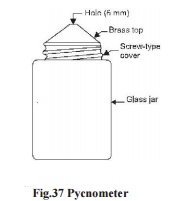
The water is then carefully drained from the sample through a
filter paper, retained being returned to the sample. The aggregate including
any solid on the filter paper should be exposed to a gentle current of warm air
to evaporate surface moisture and stirred at frequent intervals to insure
uniform drying until no free surface moisture can be seen and the material just
attains a free-running condition. The saturated and surface-dry sample is
weighted ( weight A).
The aggregate is then placed in the pycnometer which is filled
with distilled water. The pycnometer is dried on the outside and weighed
(weight B).
The contents of the pycnometer are emptied into the tray. The
pycnometer is refilled with distilled water to same level as before, dried on
the outside and weighed (weight C).
The water is then carefully drained from the sample by
decantation through a filter paper and any material retained is returned to the
sample. The sample is placed in the oven at a temperature of 100 to 110 o C for
24 ± 1/2 hours, during which period it shou ld be stirred occasionally to
facilitate drying. It is then cooled in the air-tight container and weighed
(weight D).

Where A = weight in
g of saturated surface-dry sample
B= weight in g of
pycnometer or gas jar containing sample and filled with distilled water
C= weight in g of
pycnometer or gas jar filled with distilled water only
D= weight in g of
oven-dried sample
Bulking Test for Fine Aggregate (IS:
2386 (Part III))
Fine aggregate
(sand) has a tendency to increase in volume (bulk) depending upon the moisture
present in it. In making concrete mix, if the batching in done by volume, the
actual quantity of sand in each batch will be less than the recommended volume
and actual quantity of sand in each batch will be less than the recommended
volume and consequently the mix will be rich in cement, i.e. the proportions of
cement and sand will be different to be provided. This will result in uneconomy
and may affect adversely teh concrete also. Therefore, the amount of sand will
have to be increased by percentage bulking (B).
The field method of
determination of bulking is explained in Sec. 6.3. In the laboratory test
sufficient quantity of oven dried sand is filled in graduated cylinder up to a
certain fixed mark. The sand is emptied in a container and the weigh of dry
sand is determined 1% water is added in the sand mixed thoroughly and filled in
the graduated cylinder. The volume of sand will be found to increase. The
process is repeated by increasing the percentage of water in steps of 1% each
time till a decrease in the volume of sand is observed. Still this addition of
water is continued till the volume of sand comes back to the original volume
(fully saturated).
A graph is plotted
between moisture content and percentage increase in volume. The graph will be
of the shape as shown in Fig. 6.2. The percentage bulking is given by,
B = bulked volume - dry volume ¥ 100 dry
volume
Crushing Value Test (IS: 2386 (Part
IV))
The material for
the test should consist of aggregate passing 12.5 mm sieve and retained on 10
mm sieve. For other sizes, the materials are separated on the appropriate
sieves given in Table 6.6.
Table 10 Details of Aggregate Crushing Test for Non-standard
Sizes of Aggregate

Note: About 6500 g of natural aggregate is required to provide
samples for the 150 mm cylinder, or about 1000 g for the 75 mm cylinder.
The aggregate is
tested in a surface-dry condition. The weight of material comprising the test
sample is determined (weight A).
The cylinder of the
test apparatus is positioned on the base-plate and the test sample is added in
thirds, each being subjected to 25 strokes from the tamping rod. The surface of
the aggregate is carefully levelled and the plunger is inserted so that it
rests horizontally on this surface.
The apparatus, with
the test sample and plunger in position is then placed between the platens of
the testing machine and loaded at an uniform rate as possible, so that the
total load is reached in 10 minutes. The total load should be 400 kN.
The load is released
and the whole of the material is removed from the cylinder and sieved on a 2.36
mm sieve for the standard test, or on the appropriate sieve given in Table 6.5.
The fraction passing the sieve is weighed.
The ratio of the weight of fines formed to the total sample
weight in each test is expressed as a percentage, recorded to the first decimal
place:
Aggregate crushing value = B/A ¥ 100
Where
B = weight of fraction passing the appropriate sieve
A = weight of surface-dry sample
Aggregate Impact Value Test (IS:2386
(Part IV))
The aggregate
impact value gives a relative measure of the resistance of an aggregate to
sudden shock or impact, which in some aggregate differs from its resistance to
a slow compressive load.
The test sample consists
of aggregate the whole of which passes a 12.5 mm sieve and is retained on a 10
mm sieve. The aggregate comprising the test sample is dried in an oven for a
period of four hours at a temperature of 100-110 o C and cooled.
The measure is
filled about one-third full with the aggregate and tamped with 25 strokes of
the rounded end of the tamping rod. A further similar quantity of aggregate is
added and a further tamping of 25 strokes is given. The measure is finally
filled to overflowing, tamped 25 times and the surplus aggregate is struck off,
using the tamping rod as a straight-edge. The net weight of aggregate in the
measure is determined to the nearest gram (weight A).
A cup, 102 mm
internal diameter and 50 mm deep, is fixed firmly in position on the base of
the machine and the whole of the sample is placed in it and compacted by a
single tamping of 25 strokes of the tamping rod.
The hammer is
raised until its lower face is 380 mm above the upper surface of the aggregate
in the cup, and allowed to fall freely on to the aggregate. The test sample is
subjected to a total of 15 such blows each being delivered at an interval of
not less than one second.
The crushed
aggregate is then removed from the cup and the whole of it is sieved on 2.36 mm
IS sieve until no further significant amount passes in one minute. The fraction
passing the sieve is weighed to an accuracy of 0.1 g (weight B). The fraction
retained on the sieve is also weighed (weight C) and, if the total weight (B +
C) is less than the initial weight (A) by more than one gram, the result is
discarded and a fresh test made. Two tests are made.
The ratio of the
weight of fines formed to the total sample weight in each test are expressed as
a percentage, recorded to the first decimal place:
Aggregate impact value = AB ¥ 100
Where B = weight of fraction passing
2.36 mm sieve A = weight of oven-dried sample
Aggregate Abrasion Value Test (IS:
2386 (Part IV))
The abrasion value
of coarse aggregate may be determined by either Deval Machine or by Los Angeles
machine.
Using Deval Machine
Abrasive Charge: The abrasive charge consists of
6 cast iron or steel spheres approximately 48 mm in diameter, each weighing
between 390 and 445 g. An abrasive charge of 6 spheres weighing 2500 ± 10 g is
used with each test sample.
The test sample
consists of dry coarse aggregate made up of percentages of the various sizes
conforming to one of the gradings shown in Table 6.7. The grading used should
be that most nearly representing the coarse aggregate furnished for the work.
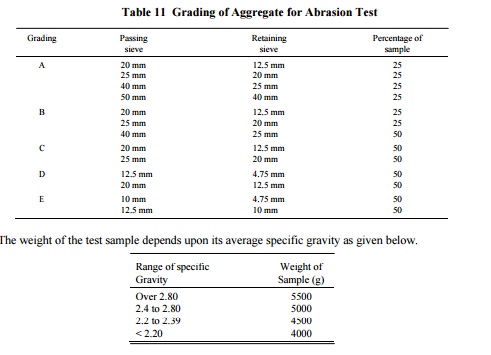
Procedure: The test sample and
the abrasive charge are placed in the Deval abrasion testing machine and the
machine is rotated for 10000 revolutions at a speed of 30 to 33 rev/min. At the
completion of the test, the material is removed from machine and sieved on a
1.70 mm sieve. The material retained on the sieve is washed, dried and
accurately weighed to the nearest gram.
The loss by abrasion is
considered as the difference between the original weight of the sample and the
weight of the material retained on the 1.70 mm sieve, expressed as percentage
of the original weight of the test sample.
In case of crushed gravel, the
percentage by weight of crushed fragments is determined, and the permissible
percentage or wear is calculated as:
W = AL (100
A)L / 100
Where W =
permissible percentage of wear
A = percentage of
uncrushed fragments
L= maximum percentage of wear
permitted by the specifications for gravel consisting entirely of uncrushed
fragments
100 - A = percentage of crushed
fragments
L = maximum
percentage of wear permitted by the specifications for gravel consisting
entirely of crushed fragments
Using Los Angeles Machine
Abrasive Charge: The abrasive
charge consists of cast iron spheres or steel spheres approximately 48 mm in
diameter and each weighing between 390 and 445 g.
The
abrasive charge, depending upon the grading of the test sample should be as
given in Table 12.
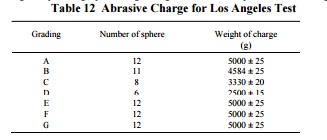
The test sample consists of clean
aggregate dried in an oven at 105 -110 o C to substantially constant weight.
Note: It is recognized that
different specification limits may be required for gradings E, F and G than for
A, B, C and D. It is urged that investigations be conducted to determine the
relationship, if any, which exists between results for these coarse gradings
using the 10000 g samples and the finer ones using the 5000 g samples.
The test sample and the abrasive
charge is placed in the Los Angeles abrasion testing machine and the machine is
rotated at a speed of 20 to 33 rev/min. For gradings A, B, C and D, the machine
is rotated for 500 revolutions; for gradings E, F and G, it is rotated for 1000
revolutions. The machine is so driven and so counter-balanced as to maintain a
substantially uniform peripheral speed. If an angle is used as the shelf, the
machine is rotated in such a direction that the charge is caught on the outside
surface of the angle. At the completion of the test, the material is discharged
from the machine and a preliminary separation of the sample made on a sieve
coarser than the 1.70 mm. The finer portion is then sieved on a 1.70 mm
sieve.The material coarser than the 1.70 mm sieve is washed, dried in an oven
at 105 -110 o C to a substantially constant weight, and accurately weighed to the
nearest gram. The difference between the original and the final weights of the
test sample expressed as a percentage of the original weight of the test sample
gives the percentage of wear.
Soundness Test (IS: 2386 Part V)
The
sample of fine aggregate for the test is passed through 10-mm IS sieve and
should be of such size that it yields not less than 100 g of each of the sizes
as below.
From the sample of coarse
aggregate, sizes finer than 4.75 mm are removed and the size of sample for
different sizes should be as follows.
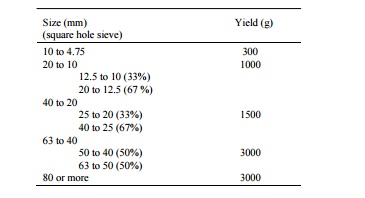
Note: All-in-aggregate should be
separated in two major fractions, finer than 4.75 mm and coarser than 4.75 mm,
and tested.
In case of fine aggregate, these
are thoroughly washed on a 300 micron IS sieve and dried to constant weight at
105 to 110 o C and separated into different sizes by the set of sieves listed
earlier to yield at least 100g each. The coarse aggregate sample are washed
thoroughly and dried to constant weight at 105 to 110 o C and separated into
different sizes. Particles coarser than the 20 mm IS sieve are counted.
The aggregate sample is immersed
for 16 to 18 hours in the prepared solution of either sodium sulphate or
magnesium sulphate solution. The sample is maintained at 27 ± 1 o C. The
aggregate sample is then removed from the solution and drained for 15 ± 5
minutes, placed in drying oven at 105 -110 o C and dried to constant weight. The
sample is allowed to cool to room temperature. The process of immersion and
drying is repeated for as many number of cycles as agreed to between the
purchaser and vendor. The sample is then examined for quantitative and
qualitative examination.
Quantitative
examination: After the completion of final cycle the cooled sample is washed
free from the sodium sulphate or magnesium sulphate with barium chloride. Each
sample is dried to constant weight at 105 - 110 o C and weighed. Fine aggregate
are sieved over the same sieve on which it was retained before the test, and
coarse aggregate over the following sieves.

Qualitative
examination: Frations of samples coarser than 20 mm are examined qualitatively
for each immersion as well as at the completion of the test. The effects
observed may be classed as disintegration, splitting, crumbling, cracking,
flaking, etc.
Related Topics